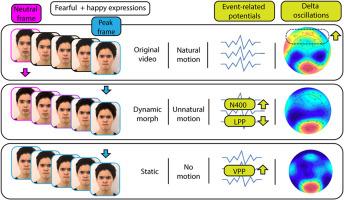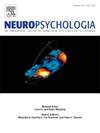EEG correlates of static and dynamic face perception: The role of naturalistic motion
IF 2
3区 心理学
Q3 BEHAVIORAL SCIENCES
引用次数: 0
Abstract
Much of our understanding of how the brain processes dynamic faces comes from research that compares static photographs to dynamic morphs, which exhibit simplified, computer-generated motion. By comparing static, video recorded, and dynamic morphed expressions, we aim to identify the neural correlates of naturalistic facial dynamism, using time-domain and time-frequency analysis. Dynamic morphs were made from the neutral and peak frames of video recorded transitions of happy and fearful expressions, which retained expression change and removed asynchronous and non-linear features of naturalistic facial motion. We found that dynamic morphs elicited increased N400 amplitudes and lower LPP amplitudes compared to other stimulus types. Video recordings elicited higher LPP amplitudes and greater frontal delta activity compared to other stimuli. Thematic analysis of participant interviews using a large language model revealed that participants found it difficult to assess the genuineness of morphed expressions, and easier to analyse the genuineness of happy compared to fearful expressions. Our findings suggest that animating real faces with artificial motion may violate expectations (N400) and reduce the social salience (LPP) of dynamic morphs. Results also suggest that delta oscillations in the frontal region may be involved with the perception of naturalistic facial motion in happy and fearful expressions. Overall, our findings highlight the sensitivity of neural mechanisms required for face perception to subtle changes in facial motion characteristics, which has important implications for neuroimaging research using faces with simplified motion.

静态和动态人脸感知的脑电图相关性:自然运动的作用。
我们对大脑如何处理动态人脸的理解大多来自于将静态照片与动态变形进行比较的研究,后者展示的是简化的、由计算机生成的动作。通过比较静态、视频记录和动态变形表情,我们希望利用时域和时频分析来确定自然面部动态的神经相关因素。动态变形是由录制的快乐和恐惧表情过渡视频的中性帧和峰值帧制成的,它保留了表情变化,并去除了自然面部运动的非同步和非线性特征。我们发现,与其他刺激类型相比,动态变形会引起更高的 N400 波幅和更低的 LPP 波幅。与其他刺激相比,视频记录会引起更高的 LPP 振幅和更大的额叶三角活动。使用大型语言模型对受试者访谈进行的主题分析表明,受试者很难评估变形表情的真实性,与恐惧表情相比,他们更容易分析快乐表情的真实性。我们的研究结果表明,用人工动作动画真实的人脸可能会违反预期(N400)并降低动态变形的社会显著性(LPP)。研究结果还表明,额叶区域的德尔塔振荡可能与快乐和恐惧表情中自然面部运动的感知有关。总之,我们的研究结果强调了面部感知所需的神经机制对面部运动特征微妙变化的敏感性,这对使用简化运动的面部进行神经影像研究具有重要意义。
本文章由计算机程序翻译,如有差异,请以英文原文为准。
求助全文
约1分钟内获得全文
求助全文
来源期刊

Neuropsychologia
医学-行为科学
CiteScore
5.10
自引率
3.80%
发文量
228
审稿时长
4 months
期刊介绍:
Neuropsychologia is an international interdisciplinary journal devoted to experimental and theoretical contributions that advance understanding of human cognition and behavior from a neuroscience perspective. The journal will consider for publication studies that link brain function with cognitive processes, including attention and awareness, action and motor control, executive functions and cognitive control, memory, language, and emotion and social cognition.
 求助内容:
求助内容: 应助结果提醒方式:
应助结果提醒方式:


